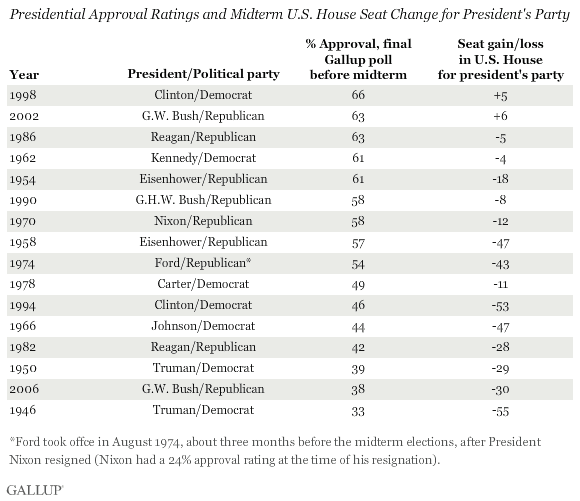PRINCETON, NJ -- Presidents who retain majority job approval from Americans at the time of midterm elections are much less likely to see their party suffer heavy seat losses than are those with sub-50% approval ratings. Since 1946, when presidents are above 50% approval, their party loses an average of 14 seats in the U.S. House in the midterm elections, compared with an average loss of 36 seats when presidents are below that mark.

The clear implication is that the Democrats are vulnerable to losing a significant number of House seats this fall with Barack Obama's approval rating averaging 45% during the last two full weeks of Gallup Daily tracking. The Republicans would need to gain 40 House seats to retake majority control.
On a historical basis, the Democrats under Jimmy Carter suffered the slimmest seat loss of a party whose president was below 50% approval, losing 11 seats in the 1978 midterms. More recently, Bill Clinton in 1994 and George W. Bush in 2006 saw their parties lose enough seats in the House to turn party control over to the opposition party when they had less than majority approval.
The president's party nearly always loses seats in midterm elections, regardless of how well the president is rated by the public. Since World War II, only Clinton in 1998 and Bush in 2002 saw their parties gain seats in a midterm. Both men had approval ratings above 60% at the time of those elections. However, the parties of the other three presidents with ratings above 60% (Eisenhower in 1954, Kennedy in 1962, and Reagan in 1986) lost seats.
In general, though, the more popular a president is, the fewer seats his party loses, as presidents with approval ratings above 60% have averaged just a three-seat loss.
Bottom Line
With the Democratic Party in control of the White House and Congress, and key predictors of midterm seat change -- including presidential approval, congressional approval, and national satisfaction -- below average historically, the Democrats are clearly fighting an uphill battle this midterm election year.
In its latest weekly update on midterm voting preferences, Gallup found more registered voters saying they would vote for the Republican candidate in their district than for the Democrat, though Democrats had better showings the prior two weeks.
As the midterm campaign kicks off in earnest after Labor Day, the Democratic Party will do its best to convince voters to keep it in the majority. It is unclear to what extent they will employ the president to help them make that case, though his ability to make a positive impact could be limited if his approval ratings continue to register below 50%.
Results are based on telephone interviews conducted as part of Gallup Daily tracking July 26-Aug. 1, 2010, with a random sample of 3,544 adults, aged 18 and older, living in all 50 U.S. states and the District of Columbia, selected using random-digit-dial sampling.
For results based on the total sample of national adults, one can say with 95% confidence that the maximum margin of sampling error is ±2 percentage points.
Interviews are conducted with respondents on landline telephones and cellular phones, with interviews conducted in Spanish for respondents who are primarily Spanish-speaking. Each daily sample includes a minimum quota of 150 cell phone respondents and 850 landline respondents, with additional minimum quotas among landline respondents for gender within region. Landline respondents are chosen at random within each household on the basis of which member had the most recent birthday.
Samples are weighted by gender, age, race, Hispanic ethnicity, education, region, adults in the household, cell phone-only status, cell phone-mostly status, and phone lines. Demographic weighting targets are based on the March 2009 Current Population Survey figures for the aged 18 and older non-institutionalized population living in U.S. telephone households. All reported margins of sampling error include the computed design effects for weighting and sample design.
In addition to sampling error, question wording and practical difficulties in conducting surveys can introduce error or bias into the findings of public opinion polls.
For more details on Gallup's polling methodology, visit www.gallup.com.
